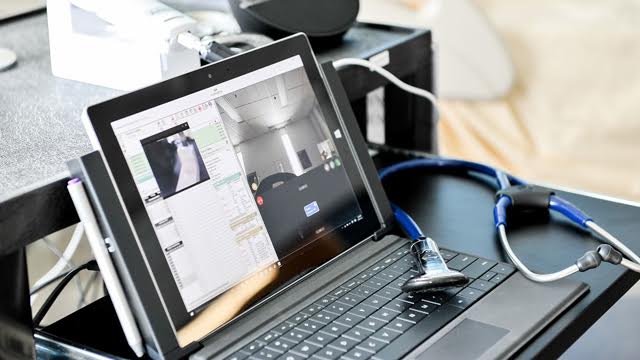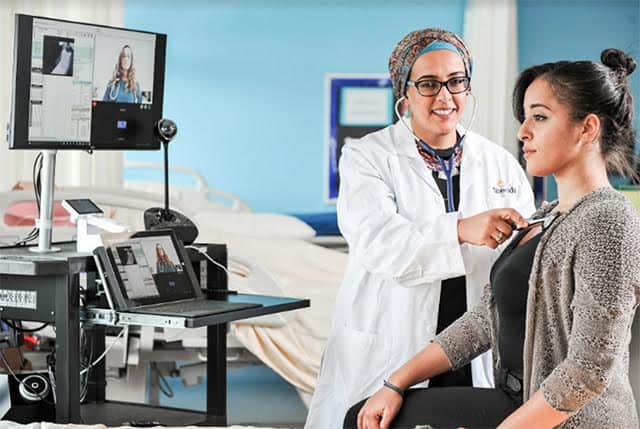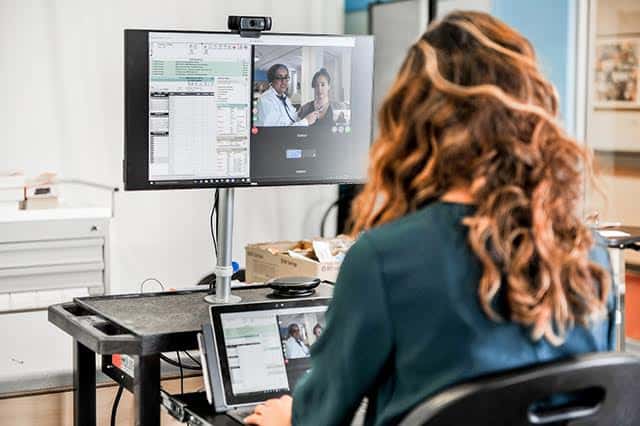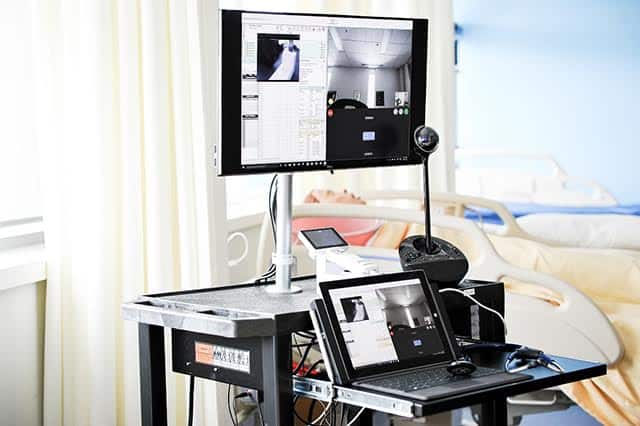Canada’s First-of-its-Kind Program Offered at Sheridan College
Published January 3, 2017 at 5:55 pm

In a world where technology dominates so many aspects of life, people–and the academic institutions that train them–must be aware of innovative new professions that, while new, will become critically important as the working world continues to evolve.
For that reason, it’s exciting that Sheridan College is offering students the opportunity to study the new (but important) field of telemedicine at the college’s Brampton-based Davis Campus.
If you’re interested in working in the health industry but do not wish to become a doctor or nurse, you might be asking yourself what, exactly, “telemedicine” means.
Basically, telemedicine–which is becoming more common in the medical industry–refers to situations in which patients attend an in-person consultation with a facilitator who records their symptoms and vital signs and communicates their case to a remote physician via state-of-the-art electronic equipment.
During a telemedicine interaction, the patient can essentially have a video conference with a doctor and receive important medical advice and, in some cases, prescription medication.
“The telemedicine facilitator is not a nurse or a doctor. He or she is facilitating between the patient and the doctor through the equipment,” explains Salwa Nahdi, a telemedicine instructor who teaches at Sheridan.
The facilitator must master both the technology and medical instruments used during the course of a typical telemedicine interaction. While conducting a remote meeting between patient and doctor, the facilitator will typically take the patient’s blood pressure and listen to their heart through a stethoscope. The doctor can actually experience what the facilitator experiences because the medical equipment will be paired, meaning the doctor can hear the patient’s heart in real-time through a stethoscope paired with the one the facilitator is using.
So, what does a telemedicine facilitator’s typical workday look like?
“When you come in as a telemedicine facilitator, there’s a workflow before you talk to the doctor,” says Nahdi. “You take in the patient and you input all their vital signs. Before that, you have to determine if the patient is eligible for a telemedicine call, because there are some things that cannot be done. The doctor can see all the information you put in on their computer. They can see the exact image of the records before seeing the patient. You call the doctor and the doctor picks up and you see each other physically on the screen, like a conference call. You can put a stethoscope on the patient and they can hear it from their end.”

While that might seem fairly unusual, there’s a reason Sheridan is pioneering the first telemedicine program of its kind.
Although the new field is still in its infancy, major clinics are dipping into it. The Appletree Medical Group, which operates in both Brampton and Mississauga, is currently working with the Ontario Telemedicine Network to expand healthcare options for patients who do not necessarily need to see a doctor in person.
Some conditions that telemedicine facilitators can help patients seek treatment for include allergy symptoms of the nose and eyes, bug bites, eczema, cold sores and cankers, ear and eye infections, female urinary tract infections, colds and flus, some prescription renewals (birth control pills, for example), head lice, minor injuries (burns, cuts), specialist referrals and more.
Telemedicine services are not appropriate for people seeking help for more intimate problems (STIs or other symptoms affecting the genitals) or for people suffering from medical emergencies (chest pain, shortness of breath, serious injury). Patients also cannot be prescribed narcotics or controlled substances through telemedicine interactions.
The program is not only innovative–it truly does offer access to the best in telemedicine equipment–it’s flexible and therefore ideal for students of all ages who want to invest in a promising career.
Right now, the program, which is currently in its first year (it debuted in the spring of 2016), consists of six courses: Human Body: Systems and Conditions, Medical Terminology 1 and 2 and Telemedicine Facilitation 1, 2 and 3.
The first three courses can be taken online and the last three offer many components that can be completed at home. Although some on-campus time is required, parts of the program can be taught remotely and some work and assignments can be submitted electronically.

All in all, it’s a program that’s ideal for students of all ages and it’s especially convenient for more mature students who work full-time and have families at home.
The field is also particularly attractive to people who worked as nurses, doctors or other medical professionals abroad who are not licensed to practice in Canada
“For most of the students who inquire, they are somewhat knowledgeable about the healthcare world. A lot of them are office admin medical students who are looking to change fields or add this to their repertoire,” explains Hayley White, telemedicine program officer. “It’s good for people who work full-time. We get a lot of inquiries from internationally trained doctors who are new to Canada who are not yet re-certified as physicians. This lets them work in their field and ease back into it and make some money. They can be in the workforce and see the new technology.”
Since both Brampton and Mississauga are incredibly diverse, the program is particularly helpful for new Canadians with medical knowledge and expertise. In fact, students who can demonstrate adequate knowledge of human anatomy and medical terminology can take a test rather than complete the program’s first three courses.
“We have something called Prior Learning Assessment and Recognition,” says White. “If someone is an internationally trained doctor, they can do a challenge exam for a fee that’s less than the cost of the courses. If they pass, they get the credits and only have to do the last three courses to get the certificate.”
While the program is a great career option, it doesn’t just benefit local students or residents seeking an exciting new career–it benefits the entire country by uncluttering the medical system.
“The goal with telemedicine is enabling healthcare solutions for everyone,” says Marcela Velez-Pulgarin, a program manager with Sheridan. “It could be for people in long-term care facilities or people who need to consult with far away specialists. So instead of patients having to go to the doctor or moving around and going through cities, they can communicate with a doctor [remotely]. Then they’ll see if there needs to be follow up or not. Up to 78 per cent of cases brought to doctor’s offices can be conducted through telemedicine.”
While the field is great for patients seeking advice for minor ailments, it’s also good for people with chronic conditions who just need to check in from time to time. It’s also ideal for people who have to connect with physicians who practice in different cities (or, in some cases, provinces).

“The government currently has to pay for transportation, so if a person in B.C. needs to see a specialist in Toronto, the government has to cover flight and accommodation costs,” says Velez-Pulgarin. “Telemedicine can solve that by having a telemedicine room in B.C. that the patient can go to and connect with the doctor. It’s good for patients with limited mobility who have to consult a doctor on a regular basis, sometimes once a week, who don’t necessarily need to see the doctor in person.”
Telemedicine can also keep emergency rooms from becoming needlessly cluttered.
“We talk about telemedicine happening in remote areas, but it is happening here. It’s happening in cities too,” says Nahdi. “If a clinic is very busy, they can ask patients if they’d like to access a doctor through telemedicine, so instead of waiting hours, you can access a doctor in non-emergency situations faster. Most cases are not emergencies. In an emergency, you will be referred to someone else.”
The program is also exciting for students who are anxious to start their careers in the growing field.
“I know that healthcare is in high demand and we’re looking to increase satisfaction and access and reduce wait times,” says telemedicine student Lakshmi Kaniselvan. “I had been reading about this kind of medicine, and now I have one more course to complete. [Since I’m familiar with the medical field], I know what we need.”
And while the program is no doubt practical, it’s also enjoyable.
“I’ve been enjoying it,” says Kaniselvan. “I gained a lot of knowledge and I find that everything is well-designed. I’m proud to be part of the first batch. It gives you so much knowledge and background.”
While it’s important to emphasize the career opportunities the program provides, it’s also imperative to appreciate the in-class preparation students receive.
The equipment itself is also top notch, effectively preparing students for the machinery they’ll encounter in the working world. One scope that facilitators use helps them provide perfect images of a patient’s skin–something that’s ideal for dermatologists who are connecting with a patient remotely.
“I just took my son to a dermatologist and there was a two-month wait and the doctor said I was lucky because in some places, there’s a nine-month wait,” says Nahdi, the course instructor. “In these cases, telemedicine works because the dermatologist is just looking and she can see the images of your skin clearly, more clearly than with the naked eye.”
Telemedicine also expands a patient’s options by allowing the facilitator to connect with more than one physician. If one doctor is busy, the facilitator can contact others on the patient’s behalf. The facilitator can also connect with nurses who specialize in specific aspects of care, such as post-surgery or injury wound care.
“This can prevent amputations by helping people care for wounds,” says Nahdi.
While the program is new and awareness is still being raised, the response from the community has been positive.
“There’s been a lot of buzz from the community because it is so innovative and it is so different. People want to know what it’s about and they’ve been intrigued. We’ve been approached by the community,” says Christine Worrall, senior marketing strategist with the Faculty of Continuing and Professional Studies. “One of the important things with telemedicine is that this is a program that pushes the conventions of regular medicine and does something a little different. It’s probably safe to say that there’s nothing else out there right now at all that offers the same type of accreditation that Sheridan does. As technology changes, we’re trying to reach so many different areas that need medicine–especially rural areas. Being able to offer such a program is very important. It’s important for Sheridan to be a part of that.”
For more information on the program, click here.
INsauga's Editorial Standards and Policies